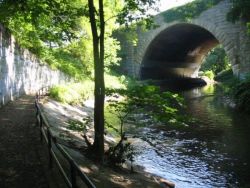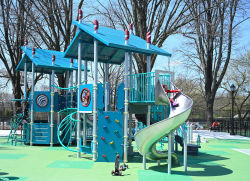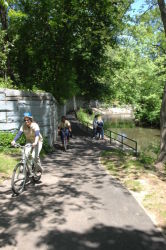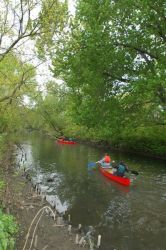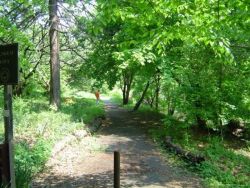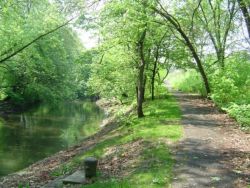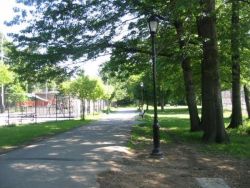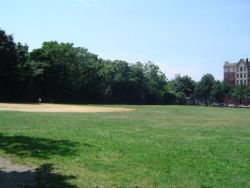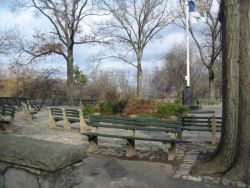Bronx Park
The Daily Plant : Tuesday, November 28, 2000
THE PROOF IS IN THE PLAYGROUND: PARKS FULFILLS ITS MISSION AS A TRULY PUBLIC SPACE
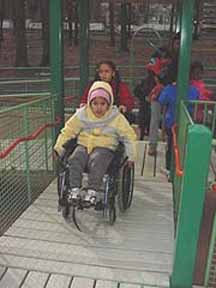
Photo by Malcolm (Cinema) Pinckney
Implicit in public parks is a message to New Yorkers: we welcome all park uses and acknowledge that our community is richer for the diversity of its members. But even parks intended for public use can exclude handicapped individuals by virtue of their design. A 1974 study by the Department of City Planning found that disabled children become isolated from the general population when they avoid buildings, streets, and facilities that are difficult to negotiate. For some children, it is nearly impossible to enter playgrounds, let alone enjoy their equipment. The study's findings sparked a decade of collaboration between City agencies, architects, recreational professionals, planners, advocacy groups for the disabled, and hundreds of children. Together they crafted the design of a $3.7 million project in Queens, the city's first Playground for All Children, a playground specifically designed to meet the needs of a wider range of users. A second playground followed in Staten Island. This week, the ribbon was cut on the third in this family of playgrounds.
Parks redesigned and expanded an existing playground in Pelham Bay Park, the Bronx. The playground is off of Middletown Road and the Bruckner Expressway. The old playground was half the size with half the clever features. This time, Parks added handrails, ramps, textured pavement, and braille. The basketball hoops were made adjustable and the swings outfitted as full seats. Bleachers with shade covers, picnic tables, and game tables provide space for a variety of activities. An up-graded parking and vehicle drop-off and a handicap-accessible comfort station further broaden the usefulness. Most unusual for a playground, nature was brought inside the boundaries of the play space. A winding path around the trees was paved to ensure that even the Bronx wilderness meets requirements for handicapped accessibility.
On Monday, November 27, 2000 a long list of prominent New Yorkers welcomed the Bronx's first Playground for All Children into existence, and showed their support of this innovation in playground design. Council Member, Madeleine (Dolphin) Provenzano, who funded the $2.59 million reconstruction; State Assemblyman, Stephen (Sechel) Kaufman; Director of the Mayor's Office of People with Disabilities, Catherine (Faith) Paradiso; Deputy Director of Intergovernmental Affairs, Robert Nolan; Regional Director of NYS Office of Parks, Recreation & Historic Preservation James F. (Taconic) Moogan represented their institutions, reinforcing the message that the city wants its public spaces to be enjoyed by the public in its entirety. Commissioner Henry J. (StarQuest) Stern, Bronx Borough Commissioner William (Zorro) Castro; Pelham Bay Administrator Linda (Hickory) Dockeray, and many Bronx Parkies represented Parks at the celebration. Bronx Borough President, Fernando Ferrer also funded the reconstruction. Schoolchildren from 5 local schools gave the equipment its first test run, and disabled adults from YAI have offered to help maintain it.
In the Playground for All Children, Parks put its blueprints where its priorities are, creating spaces that are fun and accessible for the handicapped and for all children. The newest family member promises to be a kid's haven in the city's largest park.
PARKS IMAGES PREPARE FOR THEIR CLOSE-UP AT THE SOUTH STREET SEAPORT MUSEUM
From Parks' vast archive of renderings and perspective drawings, several views will appear in a new exhibit at the South Street Seaport Museum's Melville Gallery, 213 Water Street. Bathhouses in Crotona, McCarren, Astoria, High Bridge, and Thomas Jefferson Parks will support an exhibit on utopian thought in the Progressive and New Deal eras. Steven (Pathfinder) Rizick, Parks' Director of Document Services, is responsible for the images and their inclusion, alongside highlights from the Municipal Archives, in "Healing Waters: Utopian Responses to Dirt, Disease, & Disorder 1890-1940." The exhibit opens Friday, December 15.
THIRTEEN YEARS AGO IN THE PLANT
(Tuesday, December 1, 1987)
PARKS' ANNUAL REPORT IS ISSUED
The Parks Department has published its Annual Report for calendar year 1986. The 56-page agency-wide report, which was produced by in-house staff, documents Park's various operations from its massive $1.3 billion 10-year capital plan to its graffiti fighting efforts. This latest report is the third one Parks has published after an 18-year hiatus between 1967 and 1983. "It's not easy being green, but in 1986 we steadfastly continued to defend the fauna and preserve the flora in our 26,000-acre parks system," said Commissioner Stern.
QUOTATION FOR THE DAY
"My works are in a constant state of change.... As people walk on them, as
the steel rusts, as the brick crumbles, as the materials weather, the work becomes
it's own record of everything that's happened to it."
Carl Andre (b. 1935)
Check out your park's Vital Signs
Clean & Safe
Green & Resilient
Empowered & Engaged Users
Share your feedback or learn more about how this park is part of a
Vital Park System

